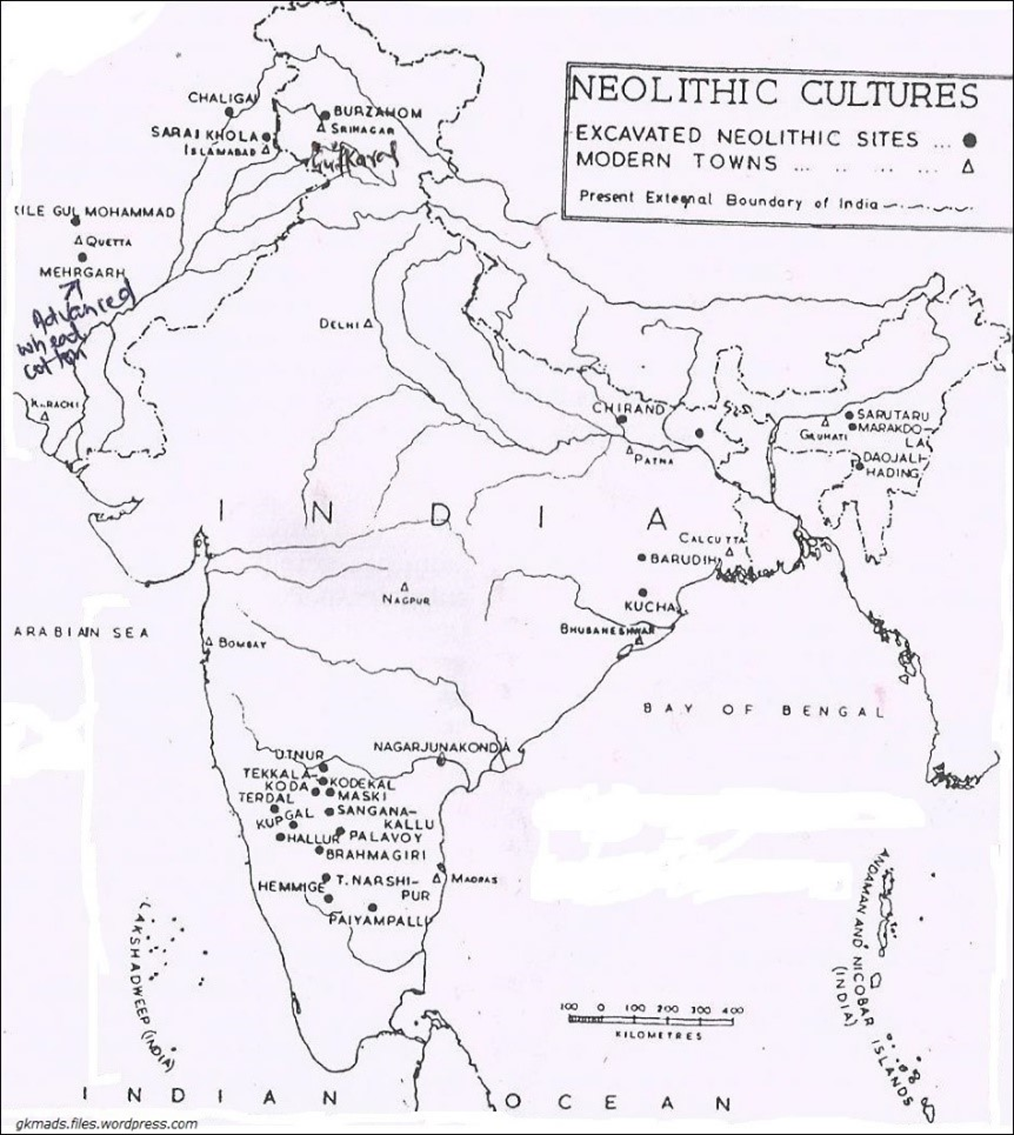Prehistoric-period / Prehistoric period / Neolithic Period
Introduction
- Refers to the last stage of the Stone Age
- Significant for megalithic architecture, spread of agricultural practices, and use of polished stone tools
- Humans no longer entirely dependent on nature, but exploiting it to their advantage
Neolithic Culture
Agriculture
- Neolithic Revolution: origin of agriculture, animal domestication, and settled way of life
- Transformation from hunting-gathering to agropastoral economy
- Cultivated ragi, horse gram, cotton, rice, wheat, and barley
- Domesticated cattle, sheep, and goats
Tools
- Use of polished stone tools and axes (celts)
- Tools and weapons made of bone
- Neolithic tools appear more refined than those of the Palaeolithic period
Living
- Introduction of domestication led to large quantities of grains and animal food
- Pottery-making emerged for storage and cooking
- Rectangular or circular mud and reed houses
- Large villages developed with permanent residences
Pottery
- Pottery first appeared in the Neolithic Age
- Classified under grey ware, black-burnished ware, and mat-impressed ware
Architecture
- Significant for megalithic architecture (large stone structures)
Community Life
- Surplus food production led to development of early urban cultures
- Neolithic people had common rights over property and led a settled life
Neolithic cultures of India
- Regional variations due to local ecological conditions
- Farming and pastoralism based sedentary/semi-sedentary village culture
- Divided into various regional cultural groups
- The Neolithic sites of the Indian subcontinent or South Asia are divided into various regional cultural groups, as follows:
Region | Important Places | Characteristic Features |
| North-Western Region – Pakistan and Afghanistan | Mehrgarh in the Kacchi plains, Kili Gul Muhammad in the Quetta valley, Rana Ghundai in the Loralai valley and Anjira in the Surab valley. | It is one of the earliest regions of the world which has given combined evidence of plant and animal domestication. |
| Northern Region – Kashmir | Burzahom, Gufkral and Kanispur | The Neolithic culture of Kashmir region was contemporary with the Harappan civilization. |
| Vindhyan Hills, the Belan and the Ganga River Valleys | The sites of ChopaniMando, Koldihwa, Lehuradeva and Mahagara in the Ganga valley are the important excavated sites of this region | The Belan river valley witnessed one of the earliest Neolithic occupations in India. |
| Mid-Eastern Ganga Valley Region | Chirand (on the banks of the river Ghagra in district Saran), Chechar, Senuwar (near Sasaram) and Taradip | The Neolithic sites of this region also have evidence for transition to the Chalcolithic |
| Central-Eastern Region | Kuchai, Golbaisasan and Sankarjang are some of the important Neolithic sites of this region | These cultures show similarities with the Neolithic complexes of east and Southeast Asia |
| North-Eastern India | Marakdola, Daojali Hading and Sarutaru are the Neolithic sites of Assam region | In north-eastern India, the Neolithic culture belongs to a slightly later period. This region today has evidence for shifting cultivation, cultivation of yams and taro, building stone and wooden memorials for the dead, and the presence of Austro-Asiatic languages. |
| South India | Sanganakallu, Kodekal, Budihal, Tekkalakota, Brahmagiri, Maski, T.Narsipur, Piklihal, Watkal, Hemmige and Hallur in Karnataka; Utnur, Pallavoy, Nagarjunakonda, Ramapuram and Veerapuram in Andhra Pradesh; and Paiyyampalli in Tamil Nadu | The Neolithic people of South India had an agro-pastoral economy. Further, the Neolithic sites of South India have ash mounds in the early stages and evidence of plant and animal domestication is found. |

Social Organization and Belief System
- Limited evidence for understanding social organization
- Sedentary and semi-sedentary settlements with tribe-level social organization
- Ownership of land and plants emerged
- Presence of small houses suggests nuclear families
- Ceramics and beads suggest improved material cultural production
- Demarcation of territories
- Dead buried within houses and animal burials found, suggesting adoption of certain rituals and worship of the dead
- Worship of natural forces and limited evidence of art objects
Conclusion
- Transition from hunting-gathering to food-producing brought important changes in social and cultural development
- Foundations for earliest Indian villages laid in Neolithic times

